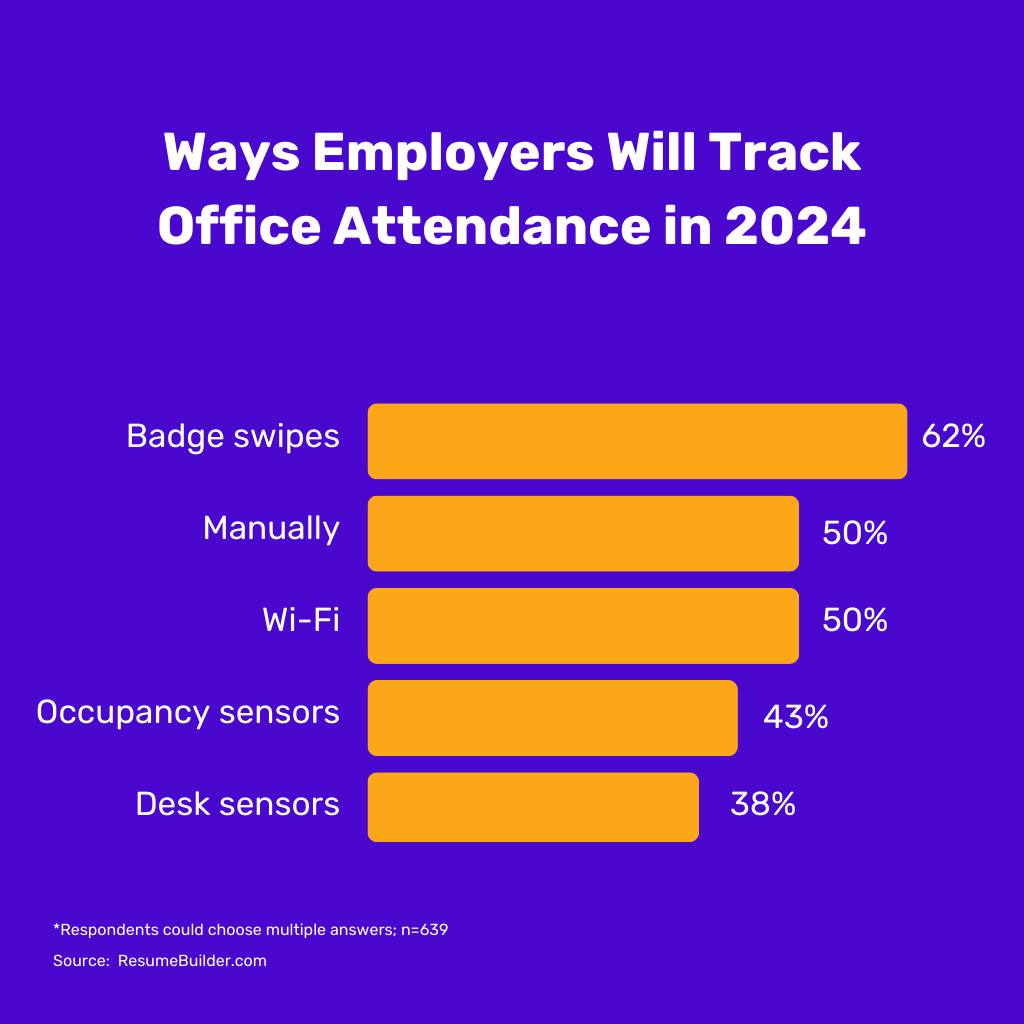
In the wake of the COVID-19 pandemic, the landscape of office attendance has undergone significant transformation, prompting companies to reevaluate their policies and practises regarding employees’ physical presence in the workplace. The post-pandemic era has sparked extensive discussions on the optimal balance between remote work and in-office collaboration, leading some companies to mandate a return to the office while others adopt hybrid models with designated office days. Amidst these shifts, a pressing challenge arises the need for accurate and efficient methods of tracking employee attendance. As organisations navigate the complexities of hybrid work arrangements, ensuring visibility into who is in the office and when becomes paramount for fostering productivity, collaboration, and resource optimisation.
Commercial real estate services and investment company CBRE conducted a Spring 2023 U.S. Office Occupiers Sentiment Survey with 207 corporate real estate executives. According to the survey, 65% of respondents reported that their companies require employees to return to the office, while only 30% maintain voluntary office attendance. Additionally, the survey found that 71% of respondents from financial/professional services companies require employees to return to the office for more than half of the week. In comparison, 56% of respondents from technology companies require attendance for less than half of the week.
According to a survey by ResumeBuilder.com, 79% of the participating companies are tracking employee office attendance. Additionally, 91% of the companies will require employees to work from the office at least one day a month, with 88% planning to definitely (70%) or probably (18%) track office attendance.
Since the beginning of the year, the pharmaceutical giant Astra Zeneca has introduced digital staff monitoring in Sweden. The company records how often employees connect to Astra Zeneca’s network to understand their presence in the office. According to an article in Dagens Industri, the company already monitors staff in the UK and USA.
AstraZeneca is not alone in tightening control over office attendance. According to the Financial Times, consulting and auditing giant EY has recently begun monitoring the office attendance of its UK employees. The company’s hybrid working policy requires employees to be in the office at least two days a week, and at least 50% of some teams still need to meet this requirement. Therefore, by monitoring attendance, EY aims to ensure compliance with the hybrid working guidelines.
Many organisations consider office attendance monitoring a crucial component of effective return-to-office (RTO) or hybrid work model management strategies. By tracking employee attendance, companies seek to ensure high productivity levels, meet deadlines, and efficiently utilise office resources. Some big tech companies like Meta Platforms, TikTok, and Google leverage swipe badge data to ensure compliance with return-to-office policies.
So it is clear that employers essentially want their employees back in the offices, to the extent that some are prepared to reward employees for doing so. An international study by the consulting firm KPMG reports that 87% of respondents are likely to reward employees who come into the office with favourable assignments, promotions, or salary increases.
According to a survey by ResumeBuilder.com, the majority of companies that are monitoring office attendance plan to use badge swipe (62%) data. Other additional methods that companies plan to use to track attendance include manual tracking (50%), Wi-Fi connection monitoring (50%), occupancy sensors (43%), and desk sensors (38%).
Badge swipes or office key cards typically involve employees swiping a physical badge or card through a reader to gain access to a building or specific areas within the building. They can also be a convenient and accurate method to record employee arrivals and departures. Some of these systems provide real-time data integration into attendance tracking systems, allowing for efficient

monitoring. Additionally, badge swipe systems are easily scalable, making them suitable for organisations of various sizes.
Manual tracking involves organisations utilising traditional methods like sign-in sheets or time clock systems for recording attendance. While these approaches provide a reliable means of tracking team attendance, particularly in smaller or less technologically advanced settings, they rely on manual input and supervision, which can lead to human error.
Wi-Fi connections allow organisations to leverage existing wireless infrastructure to monitor employee presence. This method offers an automated solution that requires minimal additional hardware and provides real-time data on employee connectivity within the office premises.
Occupancy sensors (also known as motion detectors) are an advanced technology for tracking occupancy levels within the workplace. These sensors can provide insights into workspace utilisation and traffic patterns, empowering organisations to optimise office layouts and resource allocation using data-driven insights.
Desk sensors provide detailed information on individual desk usage and occupancy, allowing organizations to understand employee work habits and preferences. This insight enables organizations to optimize desk allocation and space utilization for maximum efficiency.
As companies increasingly adopt sophisticated tools to monitor office attendance, employees are raising significant concerns about how these practises impact their work experience. Digital monitoring technologies, such as badge swipes, Wi-Fi connection tracking, and occupancy sensors, can make employees feel like they are under constant surveillance. This sense of being continuously monitored can foster a climate of distrust, where employees may feel that their autonomy and professional judgement are being undermined.
Privacy is another critical issue. Employees are often uncertain about how their attendance data will be used and who will have access to it. There is a growing fear that such data could be leveraged not just for ensuring compliance with office attendance policies but also in performance evaluations, potentially penalising those who may need more flexibility due to personal or family commitments. This can be particularly troubling for employees who have thrived in remote work settings and fear that strict in-office attendance monitoring might lead to unfair comparisons with colleagues who are more frequently present in the office.
Moreover, the rigidity of enforced office attendance through monitoring can clash with the work-life balance many employees have come to value, especially post-pandemic. The flexibility to work from home has allowed employees to manage personal responsibilities better, reduce commute times, and even increase productivity in some cases. A return to a more rigid, monitored in-office presence might not only disrupt this balance but also lead to decreased job satisfaction and increased stress. For many, the ability to work flexibly and maintain usual work-life management is seen as a key component of their job and life satisfaction, and the pressure to meet monitored attendance requirements can feel like a step backwards.
Organisations looking to implement office attendance tracking must address and alleviate employee concerns to ensure a smooth and effective transition. One of the key steps is to prioritise transparency from the outset.
Clearly communicating the reasons behind monitoring office attendance—whether it’s for optimising office space, enhancing collaboration, or ensuring equitable access to resources—can help employees understand the purpose and reduce feelings of distrust.
Companies should outline how the data will be used, who will have access to it, and how it will be protected. This transparency builds trust and reassures employees that their privacy is being respected.
Incorporating employee feedback into developing and refining attendance tracking policies is another critical factor. By actively seeking input from employees, organisations can better understand their workforce’s unique challenges and preferences. This participatory approach not only helps craft policies that align with employee needs but also fosters a sense of inclusion and ownership among employees, making them more likely to support and adhere to the new system.
Additionally, flexibility should be a cornerstone of any attendance tracking policy. While monitoring may be necessary to ensure in-office collaboration and resource management, allowing for some degree of flexibility—such as permitting remote work on certain days or providing exceptions for personal circumstances—can help balance organisational needs with employee well-being. Offering options, such as a hybrid work model, can reduce employees’ pressure from rigid in-office requirements, thereby maintaining morale and productivity.
Furthermore, it’s important for companies to focus on outcomes rather than just employee presence. Instead of using attendance data as a strict metric for performance evaluation, organisations should consider it as one of many factors contributing to overall productivity and team dynamics. Emphasising the quality of work and results, rather than mere physical presence, can alleviate employee concerns that their value to the company is being judged solely on their office attendance.
The findings from these surveys and real-world implementations underscore the pervasive influence of office attendance monitoring in contemporary corporate environments. From traditional badge swipe systems to cutting-edge occupancy sensors, companies are deploying diverse tracking tools to ensure compliance with return-to-office policies and optimise resource utilisation. As organisations strive to balance remote work flexibility and operational efficiency, the evolution of office attendance monitoring reflects a broader shift towards data-driven decision-making and adaptability in the modern workplace. Looking ahead, the continued refinement of tracking technologies and the integration of employee preferences will be pivotal in shaping the future of office attendance policies and fostering a productive, engaged workforce.
Subscribe to the monthly newsletter!
By clicking the “Subscribe” button above, you agree to the Terms & Conditions and Privacy Policy
2014 – 2025 Proudly designed and made in Lithuania